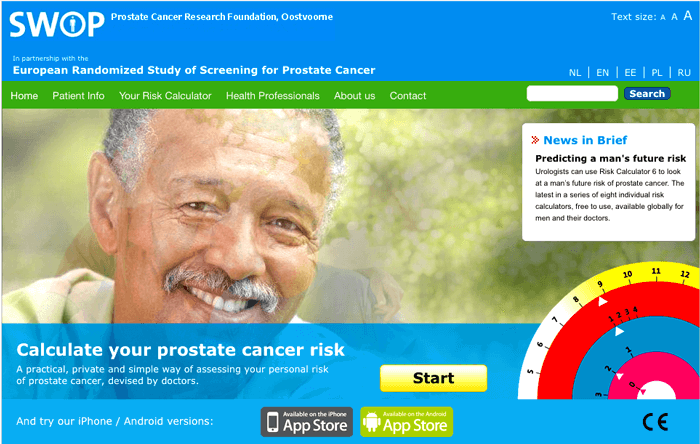Following the PROMIS trial [1], many cancer centres in the UK are now offering pre-biopsy multiparametric MRI (mpMRI) for men suitable for radical treatment. The European Association of Urology for Prostate Cancer (PCa) guidelines recommend individual risk stratification before the performance of mpMRI in men who have received a negative biopsy result [2].
The Rotterdam Prostate Cancer Risk Calculators are well validated models which help avoid 20-33% of unnecessary transrectal ultrasound guided biopsy of prostate (TRUS–Bx) [3]. The calculators have been updated to include Prostate Imaging Reporting and Data System (PIRADS) score (version 1) and age, in both biopsy-naïve men and in patients who received previous TRUS-Bx.
The updated calculators can be found in an updated version of the Rotterdam Prostate Cancer Risk Calculator app. The app can be accessed as a smartphone or tablet app, available on Android (£1.49) or iOS (£1.99) or as a series of separate calculators at:
http://www.prostatecancer-riskcalculator.com.
The updated app now uses the following parameters for the prediction of prostate cancer:
- MRI (Yes / No)
- Prostate specific antigen (PSA) (0.4-50ng/ml)
- Previous negative biopsy (Yes / No)
- Digital rectal examination (DRE) (normal / abnormal, algorithm used to populate data set where not present)
- TRUS volume (10-110ml)
- Age (50-75 years old)
- PIRADS version 1 score, 3-T MRI scanner.
What information does the app provide?
The calculator provides the detectable prostate cancer risk as a percentage. The risk is given as a score for detectable prostate cancer and for significant prostate cancer. Significant prostate cancer is defined as tumour stage greater than T2b, and / or having a Gleason biopsy score of equal to or greater than 7. The percentage risk of prostate cancer leads to the following recommended actions:
- <12.5% – no prostate biopsy
- 12.5-20% – consider prostate biopsy depending on co-morbidity and more than average risk of high-grade prostate cancer (>4%)
- 20% or more – prostate biopsy recommended.
Should you ever forget this information, it is easily accessed within the app, by touching the encircled question mark, under the percentage risks.
How does this improve on the previous prostate cancer risk app?
This cancer prediction model uses the commonly performed 12-core TRUS biopsy in combination with mpMRI targeted biopsy of PIRADS ≥3 or more lesions. Data from five different institutions, in two countries, with different targeted biopsy approaches has been combined, and this is likely to make the results more applicable to everyday variations in urological practice [3].
In biopsy naïve men, the area under the curve improved from 0.76 to 0.84 with the addition of mpMRI and age. However, using a ≥10% high-grade PCa threshold would only save 14% of TRUS biopsies, whilst missing approximately 10% of high-grade PCa [3].
In previously biopsied men, the areas under the curve improved from 0.74 to 0.85 in the updated model. In previously biopsied men, using a ≥10% high-grade PCa threshold up to 36% of further biopsies are saved, missing 4% of men with high grade PCa [3].
Previous studies, including a systematic review of negative predictive value (NPV) of mpMRI in PCa showed that the NPV was dependent on the composition of the cohort, with a lower NPV as the percentage of high-grade PCa increases. The cohort in the calculator consists of 51% PCa with any grade and 36% with high-grade PCa risk. On opening, the app suggests that it can be modified for the population (high-grade and any grade PCa prevalence) presenting to your individual centre.
Conclusion
For biopsy naïve men, at present, the RPCRC app does not appear to be a great improvement in comparison to mpMRI PIRADS score. Prostate cancer risk stratification should be part of an informed patient discussion prior to and after prostate biopsies. As such, I would still recommend the updated RPCRC app as an essential tool for urologists and any practitioners involved in prostate cancer assessment. Further refinement of such tools, validation with PIRADS version 2 scores and in further cohorts of biopsy naïve patients will hopefully make the calculators and app even more accurate long term.
References
1. Ahmed HU, El-Shater Bosaily A, Brown LC, et al. Diagnostic accuracy of multi-parametric MRI and TRUS biopsy in prostate cancer (PROMIS): a paired validating confirmatory study. Lancet 2017;389(10071):815.
2. Mottet N, Bellmunt J, Bolla M, et al. EAU-ESTRO-SIOG guidelines on prostate cancer. Part 1: screening, diagnosis, and local treatment with curative intent. Eur Urol 2017;71:618-29.
3. Alberts AR, Roobol MJ, Verbeek JFM, et al. Prediction of high-grade prostate cancer following multiparametric magnetic resonance imaging: Improving the Rotterdam European Randomized Study of Screening for Prostate Cancer Risk Calculators. Eur Urol 2018 [Epub ahead of print].
4. Moldovan PC, Van den Broeck T, Sylvester R, et al. What is the negative predictive value of multiparametric magnetic resonance imaging in excluding prostate cancer at biopsy? A systematic review and meta-analysis from the European Association of Urology Prostate Cancer Guidelines Panel. Eur Urol 2017;72(2):250-66.






